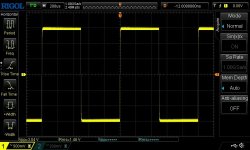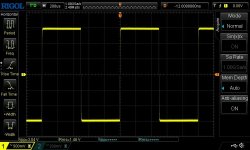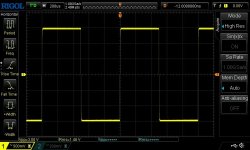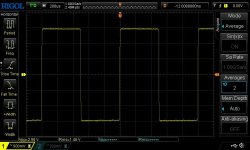I'm new to using oscilloscopes and wondering why I see a double line at the bottom of the wave. It happens with my function generator connected, but also with the built in 1kHz probe tester connection on the oscilloscope. Same result with different probes in different channels, also with the same probe in different channels. Probes have been calibrated. 1x and 10x give the same result. Coupling is DC, trigger auto or manual or single all the same results as well. Please see screenshots below:




I adjusted the time scale and it seems fine, but when I move the vertical position down, I get the double lines at the bottom, then when I move it to the top I get doubles at the top. On 10x I get the doubles at the bottom regardless of the time scale. (Last 2 pictures) Could this be a problem with the scope? (When I do a single trigger it still has the double lines.)








Last edited:
You are right, I realised that I probably changed a setting before (Display type: from Vector to Dots) and that caused the double lines. What I still don't know is why the bottom part remains much thicker than the top one when I use 'Auto' to capture the signal. I looked at the same model in YouTube when people do the same thing they seem to have uniform top and bottom. Triggering should be the same as I reset all settings and I used 'Auto' as well. Here's my result:

You may have a look into the manual and search for the acquisition mode your scope offers. My scope offers:
Sample, Peak Detect, High Resolution, Average, Envelope, Envelope+Peak Detect
With mode Sample the displayed wave form is broader, because samples are decimated (i.e., some samples are simply discarded), when the sample rate is smaller than the sample rate of the Analog-Digital converter of the scope. Hence, time resolution is then smaller .
When I switch to High Resolution, I get a nice thin line with a higher vertial resolution.
PS: A further aspect may be common mode noise, which can ruin (broaden) your signal. Dave has nice video on eevblog:
Sample, Peak Detect, High Resolution, Average, Envelope, Envelope+Peak Detect
With mode Sample the displayed wave form is broader, because samples are decimated (i.e., some samples are simply discarded), when the sample rate is smaller than the sample rate of the Analog-Digital converter of the scope. Hence, time resolution is then smaller .
When I switch to High Resolution, I get a nice thin line with a higher vertial resolution.
PS: A further aspect may be common mode noise, which can ruin (broaden) your signal. Dave has nice video on eevblog:
Last edited:
Thanks @Grauwacke , it really does look good when I set the acquisition settings to 'High Res' Also when I reduce the 'Memory Depth' to minimum, it even looks fine with 'Normal' acquisition. Although others don't have this problem with the same exact oscilloscope and default settings. I researched a bit and found that I'm not alone with this problem and it seems like it's a fault in the device.
Hi BAudio
I tried to replicate your problem on a Rigol DS1202Z-E that I have here but no luck, so I can't comment anything more than peers have written.
I would only concentrate on the hum pickup that rayma mentioned in #2 post.
As for the 'thick' top and bottom lines of the displayed SQRW (thickness indicates noise pick-up), the best remedy is to use even the lowest averaging (X2)
George
I tried to replicate your problem on a Rigol DS1202Z-E that I have here but no luck, so I can't comment anything more than peers have written.
I would only concentrate on the hum pickup that rayma mentioned in #2 post.
As for the 'thick' top and bottom lines of the displayed SQRW (thickness indicates noise pick-up), the best remedy is to use even the lowest averaging (X2)
George
Attachments
Last edited:
I see.
I hope the return transaction goes well for you.
I searched on internet for DS1104 issues and the only I got was your post here and this (input noise due to a leaky SMPS main capacitor):
Do you have any other source of info regarding your or a similar problem?
George
I hope the return transaction goes well for you.
I searched on internet for DS1104 issues and the only I got was your post here and this (input noise due to a leaky SMPS main capacitor):
George
One of the Siglent 800x series would be a nice option eventually. For now I might just get a very simple one as I'm still new to designing circuits. I'm planning to design an integrated single-ended class A amplifier. For that I don't need much bandwidth. FFT function would be nice to detect harmonics but that can wait. When I'll get there with my design, it will probably be time for a new Siglent.
- Home
- Design & Build
- Equipment & Tools
- Double bottom peak of wave forms on Rigol 1104Z Plus Oscilloscope




 The SDS800 series are 12bit vertical resolution osciloscopes.
The SDS800 series are 12bit vertical resolution osciloscopes.